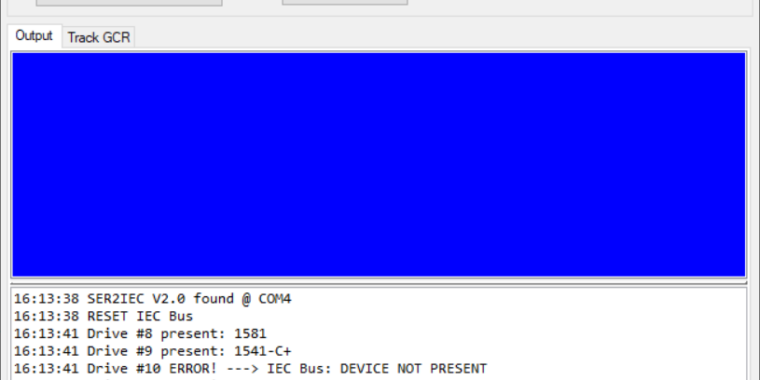

OVERVIEW
The FLOPPYmate application is a convenient tool for backing up individual PRG files and/or whole disks, sending DOS commands, as well as checking the drive’s spindle speed. Furthermore the data of a whole track can be displayed as binary and GCR.
It’s the answer to how to fast backup and restore 1541, 1571 and 1581 disks.
In order to use FLOPPYmate with your disk drive the FLOPPYmate hardware must be installed. The 6522 Fast Serial Driver is neccessary for a full FLOPPYmate functionality when accessing a 1541 drive. Otherwise its functionality is restricted to Directory, DOS command, PRG backup and PRG restore.
FEATURES
- Compatible with 1540, 1541, 1570, 1571 and 1581 drives
- Compatible with SpeedDOS and JiffyDOS
- Single file, easy-to-use application
- Automatic drive detection for bus addresses 8 to 11
- Disk backup (170KB) in 15s
- PRG file backup
- 22s fast format (1541)
- Supports 40 tracks
- Supports sector error information (D64 & D71 image formats)
- Restores G64 images
- RPM spindle speed check (154x & 157x)
- Complete ROM dump within a second
- Track dump as binary and GCR, including header and gap data
Sytem Requirements and Installation
| Operating System | Windows 7 or later (Linux and OS X portable source code) |
| Hard Drive Space | 2MB |
- Create a folder named ‘FLOPPYmate’ on your PC
- Copy the file ‘FLOPPYmate.exe’ into the ‘FLOPPYmate’ folder
- Copy all .h65 files into the ‘FLOPPYmate’ folder
FLOPPYmate was developed under PUREBASIC. Its source code can be ported to Linux and OS X.
FLOPPYmate User Manual





G64 Restore

This feature allows the replication of copy protected disks from G64 images. A D64 disk image holds only the payload of each DOS sector, whereas a G64 disk image contains the low level GCR encoded information of all DOS and/or non-DOS tracks. Currently FLOPPYmate cannot restore some of the existing G64 images.
A famous copy protection back in the day was the so called ‘long track’ method. The actual track data capacity is increased by a few dozen bytes by slowing down the RPM of the disk during write operation. These extra bytes can be read, but they can not be replicated at the nominal 300 RPM.
Therefore, the drive’s RPM is crucial for a successful G64 track replication. Adjust the RPM approximately to the lowest value in the column RPM (see below) using the ‘RPM adjust’ function. The RPM is set to 300 after selecting another drive or to the actual RPM when using the ‘RPM adjust’ or ‘RPM check’ function. Track data will be truncated according to the actual track capacity which is related to the RPM.
The RPM on belt drive mechanism can be easily adjusted by a potentiometer. A hack is needed in order to adjust a direct drive mechanism. Use an oscillator circuit (e.g. NE555) with adjustment pot and set it up to the frequency printed on the ceramic resonator placed on the motor PCB (e.g. ‘462’ = 462kHz). Remove the resonator and instead inject the signal via a series resistor (ca. 10kOhm) and a DC blocking capacitor (ca. 1nF).
Spindle Motor Oscillators:
1571 614kHz
1541-II 462kHz 1991 CHINON FZ-501M/SANKYO SB94A
1541-II 616kHz 1988 CHINON FZ-501M/SANKYO SB27D
1541-II 800kHz 1992 DIGITAL SYSTEMS (JPN CORP.) DS-50F/KUMAGAYA SMK35S
OC-168 787kHz
